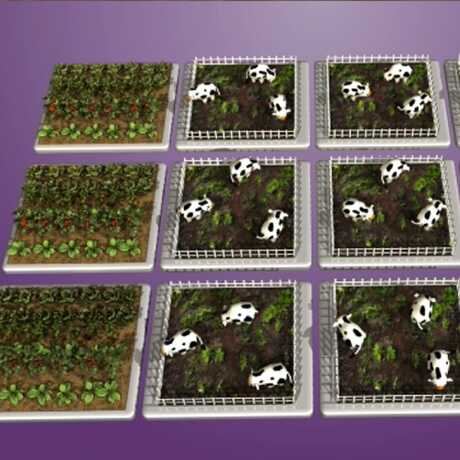Food, water, energy—we need solutions to the environmental issues of our day.
In this lesson, students will practice rapid ideation—an important step in design thinking—by brainstorming solutions to issues surrounding our current food system.
The purpose of rapid ideation is to produce an abundance of ideas in a short amount of time unconstrained by judgments or perceived limitations. Rapid ideation promotes out-of-the-box thinking and creativity, and can lead to highly innovative and perhaps unanticipated solutions to complex problems. In this activity, students will not proceed beyond the rapid ideation stage to the actual implementation of a solution, as the goal of this lesson is not to lead students through a full design thinking process. However, in the final activity of this unit, your students can participate in a design thinking challenge to develop solutions for a sustainable food issue at home or school.
- What are some issues we are facing today surrounding our current food system, and how might we design solutions for these issues?
- What are some advantages of rapid brainstorming?
- Why is brainstorming an important step in designing solutions?
Students will
- Discover some of the different issues we are facing today surrounding our current food system.
- Practice rapid and creative ideation in the context of designing solutions for issues surrounding our current food system.
- Food system: A food system is all of the steps a food goes through from being grown to being consumed. This could include processing, packaging, transporting, and selling.

- Computer with Internet access
- Projector
- Flipside Science video: The Environmental Impact of Feeding the World
- Student Worksheets (1 per student, also available in Spanish, Simplified Chinese, and Traditional Chinese)
- Stopwatches or timers (1 per group of 2 students)
We recommended you progress through the Food for Thought: Defining a Problem to Find a Solution and Exploring the Impacts of Feeding the World activities before continuing with this one. You can also use this lesson independently.
1. Divide students up into pairs. You (the teacher) will challenge students with a question to which the students will be asked to brainstorm solutions. Their goal is to brainstorm (individually) as many solutions as they can in two minutes. Challenge them to try to come up with 10-15 solutions. They should write these solutions down in their notebooks or on a piece of paper.
Challenge question options (or make up your own!):
- How could you find a needle in a haystack?
- How could you heat up a bowl of soup without a stove or microwave?
- How could you open a jar without touching it directly with your hands?
- How could you move water up a hill?
2. Remind students that the goal is to try to think of as many solutions as they can without worrying about how ‘good’ the solutions might be.
3. After the two minutes are up, the students will stop writing and compare lists with their partners.
4. Briefly discuss the exercise.
- Did you find it easy or difficult to brainstorm solutions?
- Did you think any of your ideas were silly or wacky? Would you have included those ideas in the list if you were asked to only write down ideas that you thought were ‘good’?
- Do you think there is an advantage to brainstorming as many ideas as you can and not worrying about how good, bad, silly, or strange they might seem?
Teacher note: If you preceded this activity with the Exploring the Impacts of Feeding the World activity, you can skip steps 1 and 3 below.
1. Hand out to students or write on the board a list of questions for them to think about while they watch the Flipside Science: The Environmental Impact of Feeding the World video (see below).
2. Show students the video.
3. Ask student to jot down some of their thoughts about the questions that they were asked to consider while watching the video. Give them about 10 minutes to do this. You might want to play the video another time through for students. Briefly discuss these questions as a class after students have had a chance to reflect individually.
- What kinds of issues surrounding our current food system were raised in the video?
- What impacts does agriculture have on the environment?
- How is the American diet different from other diets around the world?
- Does everyone have the same food choices? What influences the types of foods a person has access to?
- What do you do with food on your plate that you don’t finish?
4. Ask students to choose one of the main issues introduced in the video to focus on (food waste, food deserts, agricultural land use, and the environmental impacts of diet choices) and to find a partner who chose the same issue. Note: To expedite this process or if you would like to ensure that all food system issues are represented, you can also have students pick food system issues out of a hat and pair up that way too.
5. Hand out one Student Worksheet to each student. Instruct students to work with their partners to figure out a way to express the food system issue they chose in the form of a question, and to write their question on their worksheet. Give students about 5-10 minutes to work on this, helping to facilitate the process where needed. Here are some examples of questions students might consider:
- How could we motivate people to change their diets to lower their impact on the environment?
- How could we provide more fresh, healthy foods to people who currently don’t have access to them?
- How could we decrease the amount of food waste generated by restaurants/grocery stores/our school cafeteria?
- How could we grow more food with less land?
6. Hand out one stopwatch or timer to each pair, and briefly show students how to use them if needed. At this point, students will guide themselves through the next few steps of the activity, which include working through the process of facilitating their own rapid brainstorming sessions with their partners and comparing their ideas. Give students about 20 minutes for this part of the activity, reminding them when they have 10 minutes and 5 minutes left.
1. Come back together as a class, and ask for volunteers to share some of their questions and brainstorms.
2. Reflect on the activity:
- Why do you think we tried to brainstorm as many ideas as we could instead of just trying to think of one or two ‘good’ ideas?
- Are there easy solutions to the issues you learned about in the video? Is there only one solution to each issue?
- When thinking about which of your solutions might be the ‘best,’ what was your criteria? For example, did you think about the potential environmental impacts of the solution, or how expensive the solution would be to carry out?
- Design for Change design thinking for students: Feel-Imagine-Do-Share
- Designing with creativity for sustainability: Explore the efficient building design of the California Academy of Sciences
NGSS Science and Engineering Practices (Grades 6-8)
- Developing Possible Solutions
- Asking Questions and Defining Problems
California's Environmental Principles and Concepts
- Principle V: Concept a
Sustainable Food Solutions
Explore the pros and cons of some of the solutions that have been proposed for issues surrounding our global food system in the next activity.
To feed our growing world, we need innovative solutions. In this unit, we'll explore environmental issues related to the food we grow and eat. We'll review topics from food waste to urban farming, and learn how simple choices we make impact our planet.
Browse All Materials:
- Activity: Food for Thought
- Activity: Exploring the Impacts of Feeding the World
- Activity: Rapid Brainstorming [you are here]
- Activity: Sustainable Food Solutions: Weighing the Pros and Cons [up next!]
- Video: Urban Farming
- Video: Vertical Farming
- Video: Reducing Food Waste
- Video: Think Before You Eat
- Activity: Our Hungry Planet: Design Thinking Challenge
- Supplemental video: What's Up With Your Gut Microbiome?
- Supplemental video: Why Protect Pollinators?
- Supplemental video: Bugs for Breakfast
